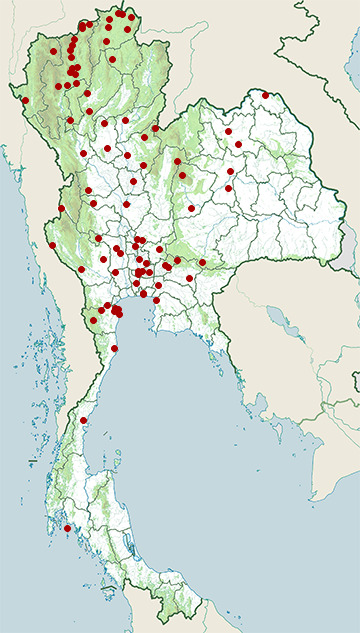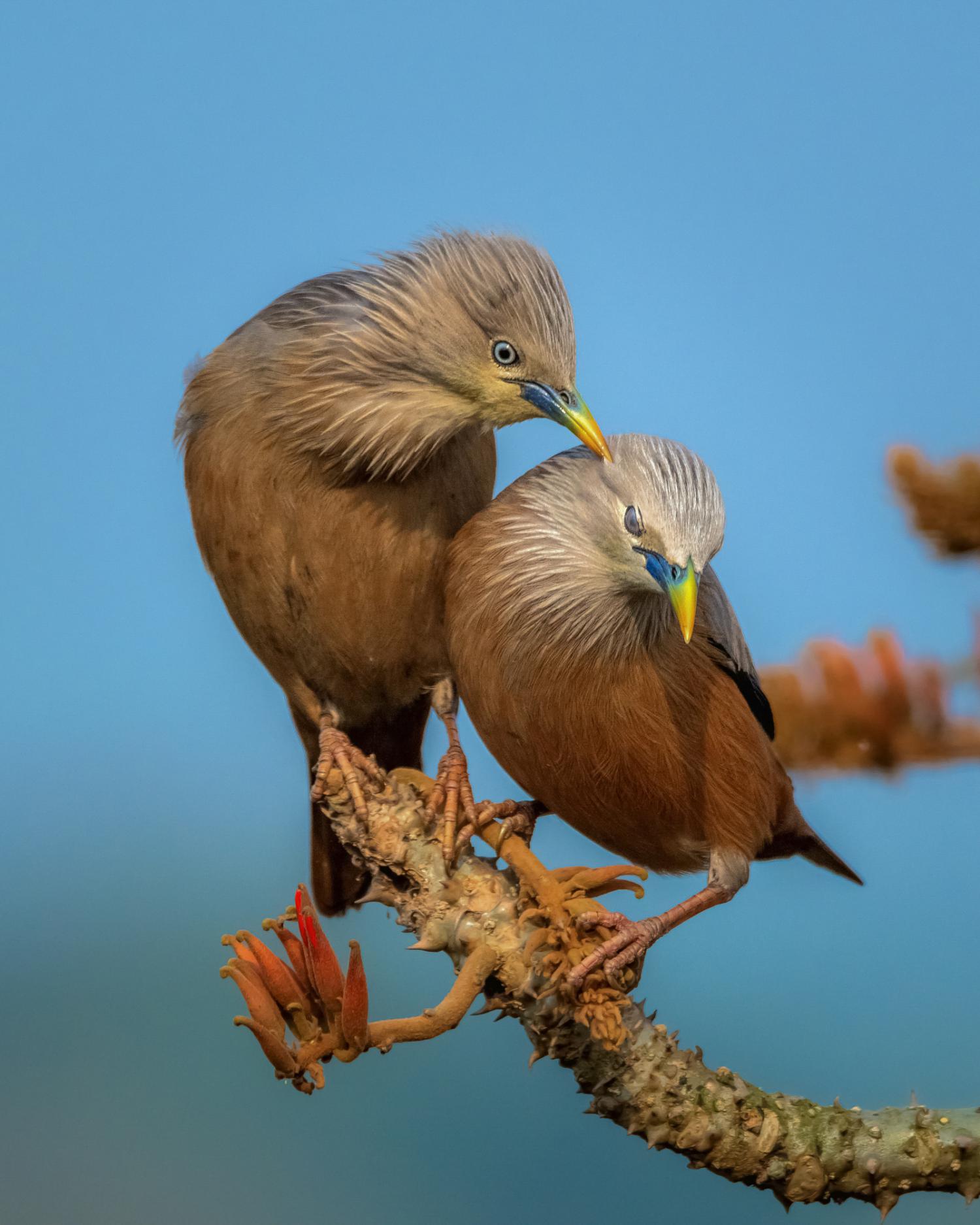Species of Thailand
Chestnut-tailed starling
Sturnia malabarica
Johann Friedrich Gmelin, 1789
In Thai: นกกิ้งโครงแกลบหัวเทา
The chestnut-tailed starling or grey-headed myna (Sturnia malabarica) is a member of the starling family. It is a resident or partially migratory species found in wooded habitats in India and Southeast Asia. The species name is after the distribution of a former subspecies in the Malabar region. While the chestnut-tailed starling is a winter visitor to peninsular India, the closely related resident breeding population with a white head is now treated as a full species, the Malabar starling (Sturnia blythii).
Taxonomy and distribution
The lack of monophyly in the earlier starling genera has led to this species being placed variously under genus Sturnia, Sturnus and Temenuchus in the past (Zuccon et al., 2006) and studies have suggested the reuse of an old name Temenuchus for members of this clade. Later studies have suggested placement in the genus Sturnia.
There are two subspecies of the chestnut-tailed starling:
- S. m. malabarica: northeastern India, Nepal, Bhutan, Bangladesh and northwestern Burma
- S. m. nemoricola: southern China, Taiwan, Burma, Thailand, Laos, Vietnam and Cambodia
Both the nominate subspecies and nemoricola are known to perform some poorly understood movements (e.g., S. m. malabarica has been recorded from Pakistan and in central and southern India).
The taxon blythii is now usually (e.g. Rasmussen & Anderton, 2005) considered a valid species, the Malabar starling or white-headed myna (Sturnia blythii), instead of a subspecies of Sturnia malabarica. As S. m. malabarica only visits the range of blythii during the non-breeding period (winter), the two are not known to interbreed. However, a molecular study found the genetic divergence between S. blythii not significantly greater (between 0.2% and 0.8%) than between the sisters S. m. malabarica of northern India and S. m. nemoricola of Burma and Vietnam.
Description
The adults have a total length of approximately 20 cm. They have grey upperparts and blackish remiges, but the colour of the remaining plumage depends on the subspecies. In the nominate subspecies and blythii, the underparts (incl. undertail) are rufous, but in nemoricola the underparts are whitish tinged rufous, especially on the flanks and crissum (the undertail coverts surrounding the cloaca). The nominate and nemoricola have a light grey head with whitish streaking (especially on crown and collar region). Both subspecies have white irises and a yellow bill with a pale blue base. The sexes are similar, but juveniles have whitish underparts and just chestnut tips to the tail feathers.
Behaviour
The chestnut-tailed starling's nest is typically found in open woodland and cultivation. The chestnut-tailed starling builds a nest in hole. The normal clutch is 3-5 eggs.
Like most starlings, the chestnut-tailed starling is fairly omnivorous, eating fruit, nectar and insects. They fly in tight flocks and often rapidly change directions with great synchrony.
This article uses material from Wikipedia released under the Creative Commons Attribution-Share-Alike Licence 3.0. Eventual photos shown in this page may or may not be from Wikipedia, please see the license details for photos in photo by-lines.
Category / Seasonal Status
Wiki listed status (concerning Thai population): Resident and winter visitor
BCST Category: Recorded in an apparently wild state within the last 50 years
BCST Seasonal statuses:
- Resident or presumed resident
- Non-breeding visitor
Scientific classification
- Kingdom
- Animalia
- Phylum
- Chordata
- Class
- Aves
- Order
- Passeriformes
- Family
- Sturnidae
- Genus
- Sturnia
- Species
- Sturnia malabarica
Common names
- Thai: นกกิ้งโครงแกลบหัวเทา
Synonyms
- Temenuchus malabaricus
Conservation status

Least Concern (IUCN3.1)
Photos
Please help us review the bird photos if wrong ones are used. We can be reached via our contact us page.
Range Map

- Ban Laem District, Phetchaburi
- Ban Phai District, Khon Kaen
- Bang Pu Recreation Centre
- Bangkok Province
- Bueng Boraped Non-Hunting Area
- Chaiyo District, Ang Thong
- Chat Trakan Waterfall National Park
- Chatturat District, Chaiyaphum
- Chiang Dao District, Chiang Mai
- Chiang Dao Wildlife Sanctuary
- Chiang Khong District, Chiang Rai
- Chiang Saen District, Chiang Rai
- Dan Chang District, Suphan Buri
- Doi Inthanon National Park
- Doi Lo District, Chiang Mai
- Doi Pha Hom Pok National Park
- Doi Suthep - Pui National Park
- Don Chedi District, Suphan Buri
- Fang District, Chiang Mai
- Hang Chat District, Lampang
- Huai Krachao District, Kanchanaburi
- Kabin Buri District, Prachinburi
- Kaeng Khoi District, Saraburi
- Kaeng Krachan National Park
- Kamphaeng Saen District, Nakhon Pathom
- Khao Sam Roi Yot National Park
- Khao Yai National Park
- Khao Yoi District, Phetchaburi
- Khlong Luang District, Pathum Thani
- Khun Tan District, Chiang Rai
- Kumphawapi District, Udon Thani
- Kut Thing Non-Hunting Area
- Laem Pak Bia
- Mae Ai District, Chiang Mai
- Mae Chan District, Chiang Rai
- Mae Ping National Park
- Mae Poen District, Nakhon Sawan
- Mae Rim District, Chiang Mai
- Mae Taeng District, Chiang Mai
- Mueang Chachoengsao District, Chachoengsao
- Mueang Chiang Mai District, Chiang Mai
- Mueang Chiang Rai District, Chiang Rai
- Mueang Chonburi District, Chonburi
- Mueang Chumphon District, Chumphon
- Mueang Khon Kaen District, Khon Kaen
- Mueang Lamphun District, Lamphun
- Mueang Lopburi District, Lopburi
- Mueang Nakhon Nayok District, Nakhon Nayok
- Mueang Pathum Thani District, Pathum Thani
- Mueang Phayao District, Phayao
- Mueang Phetchaburi District, Phetchaburi
- Mueang Phitsanulok District, Phitsanulok
- Mueang Sukhothai District, Sukhothai
- Mueang Suphanburi District, Suphan Buri
- Mueang Tak District, Tak
- Mueang Udon Thani District, Udon Thani
- Mueang Uttaradit District, Uttaradit
- Nam Nao National Park
- Noen Maprang District, Phitsanulok
- Nong Bong Khai Non-Hunting Area
- Nong Ya Plong District, Phetchaburi
- Pai District, Mae Hong Son
- Pak Phli District, Nakhon Nayok
- Pak Thale
- Pang Sila Thong District, Kamphaeng Phet
- Pha Daeng National Park
- Phan District, Chiang Rai
- Phi Phi Islands
- Phra Nakhon Si Ayutthaya District, Phra Nakhon Si Ayutthaya
- Phu Khiao Wildlife Sanctuary
- Phu Suan Sai National Park
- Sai Yok District, Kanchanaburi
- Salawin National Park
- Samut Prakan Province
- San Sai District, Chiang Mai
- Si Satchanalai District, Sukhothai
- Sop Prap District, Lampang
- Taphan Hin District, Phichit
- Tha Wung District, Lopburi
- Thanyaburi District, Pathum Thani
- Thap Lan National Park
- Thong Pha Phum National Park
- Thung Yai Naresuan Wildlife Sanctuary
- Wang Noi District, Phra Nakhon Si Ayutthaya
- Wat Phai Lom & Wat Ampu Wararam Non-Hunting Area


